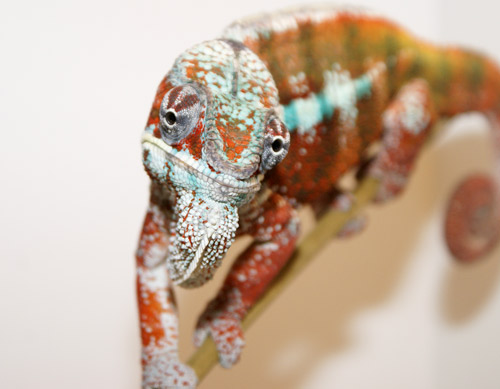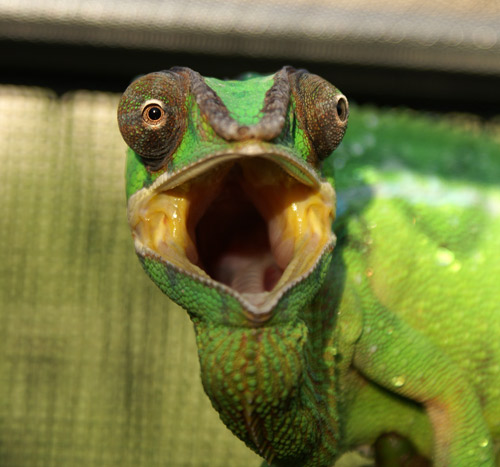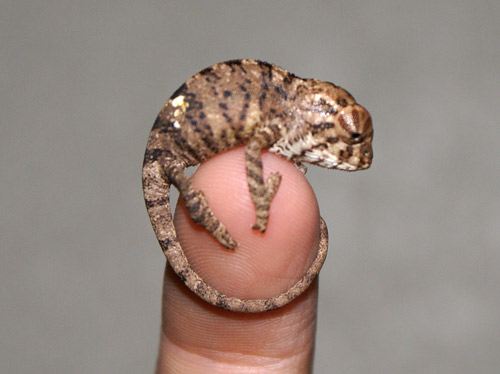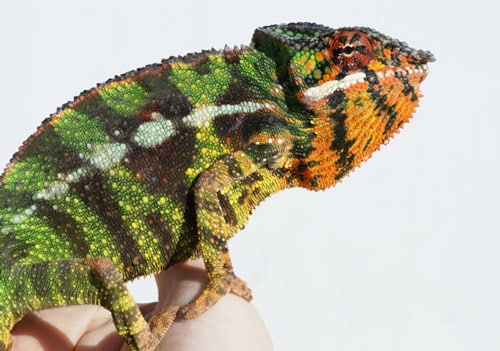Care sheet for the panther chameleon (Furcifer pardalis).
Panther Chameleons (Furcifer Pardalis)
Panther chameleons are one of the most colorful chameleon species available today. Native to Madagascar, they are able to turn a wide variety of colors depending on their locale or the area from which their line originated.
Panther Chameleon Availability
Panther chameleons are commonly available from reputable breeders and can usually be found at local reptile shops, reptile shows or through the Internet. Ambilobes are the most common locale; however, others, such as Nosy Be, are becoming more widely available. Depending on their size and color, panther chameleons can vary in price.
Panther Chameleon Size
Male panther chameleons typically have a body length of 12 to 18 inches while females are slightly smaller at 10 to 14 inches. A healthy male panther chameleon will average between 140 and 180 grams in weight, and a healthy female panther chameleon will weigh around 60 to 100 grams.
Panther Chameleon Life Span
Panther chameleons can have a varied life span depending on the care they are given. Under good conditions, your panther chameleon should live 5 to 7 years.

Photo Credit: Chad New
Adult Tamatave Panther Chameleon from TikiTikiReptiles.com
Panther Chameleon Caging
To make locating prey items easier for your baby panther chameleon, cage your new pet in a small enclosure. All screen cages 16 inches long by 16 inches wide by 20 inches tall will work for the first six months of life. After that, adult male panther chameleons should be kept in a minimum of 18 inches long by 18 inches wide by 36 inches tall enclosures, whereas female panther chameleons can be kept in 16 inches long by 16 inches wide by 30 inches tall enclosures. These sizes are the absolute minimum, and as always, bigger is better! Decorate the cage with live, nontoxic plants and various sticks or vines. Ficus Benjamina, Schefflera, and Pothos plants all make great choices. Chameleons love to climb, and live plants will give them places to hide and feel secure. Screen is always preferred over glass, as chameleons can easily get an upper respiratory infection if kept in stagnant air.
Panther Chameleon Lighting and Temperature
Provide two types of light: one UVB bulb (I recommend the ReptiSun 5.0) and one incandescent bulb of appropriate wattage. Adult panther chameleons need a basking spot of around 100 degrees Fahrenheit with the ambient temperature between 75 to 85 degrees; smaller panther chameleons should have a basking area of 85 to 90 degrees with a lower ambient temperature of around 75 degrees. It is important for panther chameleons to thermoregulate. That is why you place lights toward the top of the cage.

Photo Credit: Chad New
Adult Nosy Mitiso Panther Chameleon from TikiTikiReptiles.com.
Panther Chameleon Substrate
Chameleon cages are best left with a bare bottom. Substrate will only complicate the cleaning of your chameleon’s cage and give insects a place to hide. If you choose to have substrate, keep it simple with paper towels or newspaper. Humidity is provided when you water your plants and chameleon.
Panther Chameleon Food
A good diet is a varied diet! Crickets are the main staple, but superworms, silkworms, hornworms, waxworms, roaches, stick bugs, etc., can all – and should all – be offered to your panther chameleons. Make sure you feed gut-loaded insects. It is also necessary to dust your insects with vitamin powders. You can do this a number of ways. I recommend doing calcium three times a week, calcium with D3 once a week, a small dusting of Miner-All one time a week and Herptavite one time every other week.

Photo Credit: Chad New
Hatchling Nosy Be Panther Chameleon from TikiTikiReptiles.com.
Panther Chameleon Water
Water is one of the most important things to consider when keeping a panther chameleon, as they love to drink and need to every day. Misting the chameleon two to three times a day will keep the humidity in the required 60 to 70 percent range and will also allow the animal a chance to drink. I also suggest running a drip system most of the day at least twice a week. This will allow the panther chameleon to drink nice full drops of water whenever it likes. It will also keep your plants watered.
Panther Chameleon Handling and Temperament
Panther chameleons are one of the more docile of the common chameleon types, though you can get an occasional grumpy one. It is important to remember that chameleons like to be left alone. They are a great display animal that should not be handled on a daily basis. Some tips to remember when handling a chameleon are to approach the chameleon from the bottom. A hand coming from above can be taken as an attack. If you have a grumpy chameleon, first coax it onto a stick and then onto your hand or arm. With time, most chameleons come to associate their owner with food and will often come to the door in anticipation of feeding.
Chad New is the source for Panther Chameleon information and breeding. Please visit his site at TikiTikiReptiles.com.


